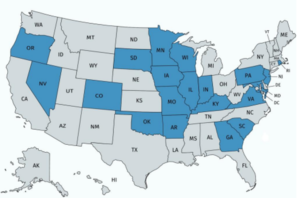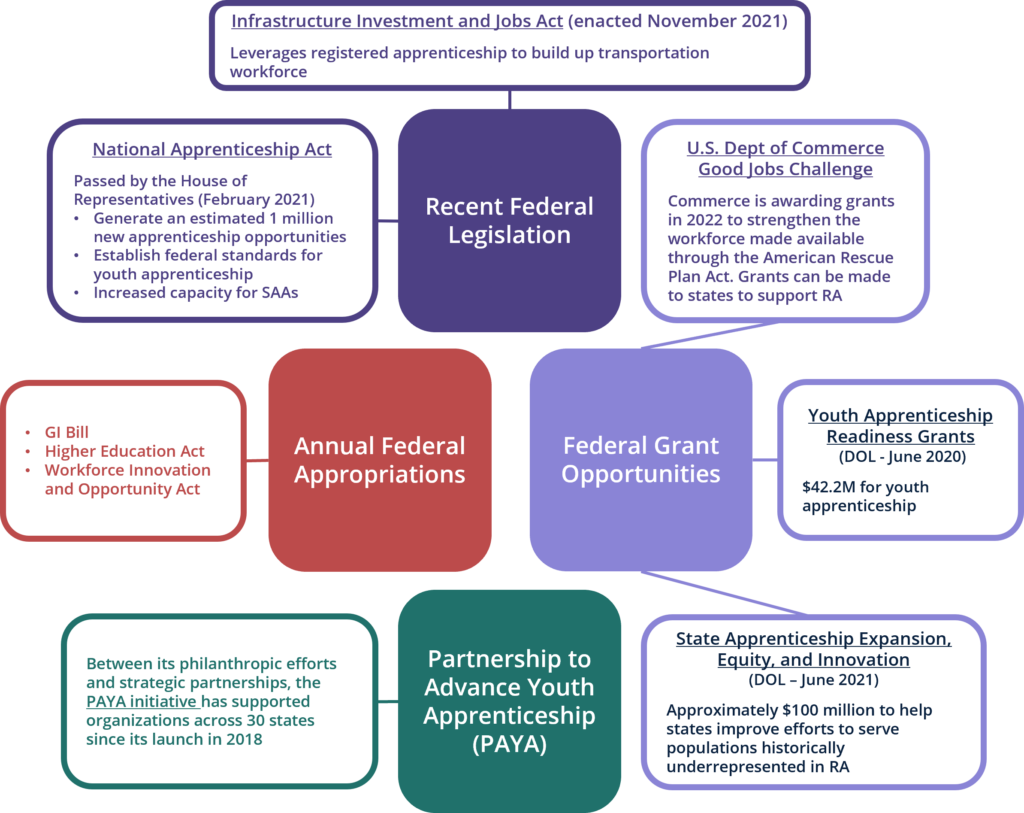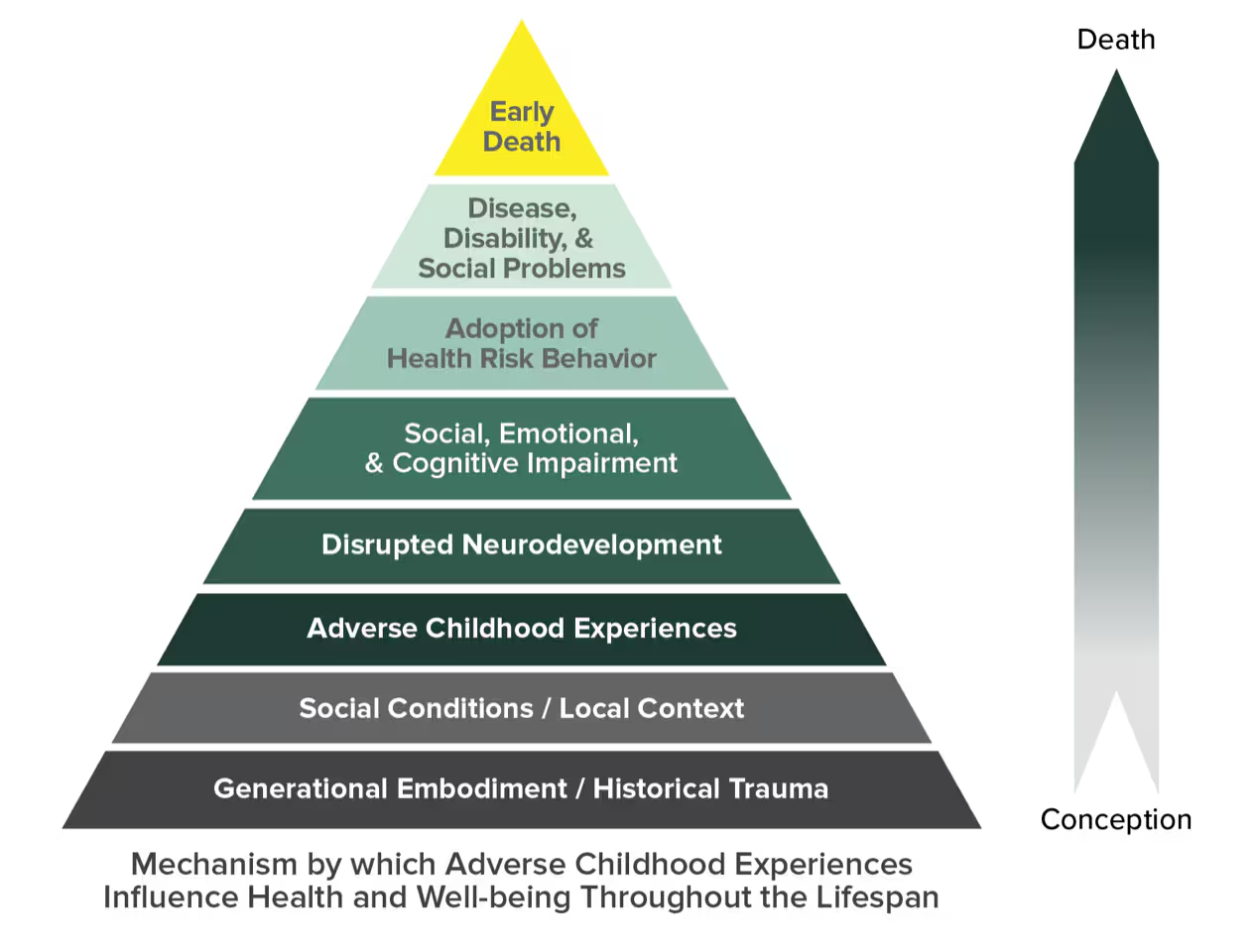As Governors continue to navigate an evolving labor market and economic climate, registered apprenticeship can be leveraged as a proven strategy for bolstering both businesses and workers.
(Download)
Executive Summary
As the state’s chief executive, one of Governors’ top priorities is ensuring that every resident can get into well-paying, stable careers through accessible, affordable education and training. Governors are also responsible for creating an economic climate that is attractive to employers and ensuring companies remain able and willing to do business in their state. A strong talent pipeline that can meet industry needs is a critical component for creating this type of business-friendly climate, and the socioeconomic upheaval brought on by COVID-19 that compounded existing inequities in the labor market has made this matter more pressing. Scaling and sustaining robust, equitable registered apprenticeship and youth apprenticeship ecosystems is a reliable and proven approach Governors can take to ensure their state is economically competitive and that every youth and adult – regardless of race, gender, ability, prior educational background or socio-economic status – can access quality training pathways that lead to family-sustaining careers.
There are several levers of policy and influence that Governors can use to place registered apprenticeship and youth apprenticeship at the center of their workforce development efforts and empower learners and jobseekers who have been traditionally marginalized or underserved. Fundamental policy decisions such as how resources are allocated can be as crucial as the convening authority and advocacy that Governors are uniquely positioned to employ in support of registered apprenticeship and youth apprenticeship. Staff at the National Governors Association Center for Best Practices (NGA Center) conducted interviews with state leaders to inform this playbook and provide Governors with actionable steps they can take to efficiently scale registered apprenticeship. The following opportunities for Governors emerged from those interviews:
- Set a clear, statewide vision for how registered apprenticeship and youth apprenticeship can meet 21st century workforce needs and expand access to quality career pathways.
- Develop a governance structure that best suits your state for apprenticeship and clearly identify who will administer programs, who they will partner with, and how programs will be implemented.
- Use the power of the office to convene stakeholders and decide who is at the table – and build relationships with those who are not at the table, but ought to be.
- Coordinate a funding strategy by proactively pursuing federal grants and considering state investments, as well as private or philanthropic resources to fill gaps or complement available uses of public funding.
- Make the state a model to employers by developing and scaling registered apprenticeship and youth apprenticeship programs in offices across the executive branch.
- Consistently advocate for and bring attention to registered apprenticeship programs and stakeholders.
- Establish a set of federal policy priorities that align with your state’s interests.
Background and State of Play for Apprenticeship
President Franklin Roosevelt enacted the National Apprenticeship Act in 1937, which codified registered apprenticeship as a national strategy to meet business needs and offer apprentices the opportunity to earn a wage while undergoing occupation-specific job training. More than 80 years later, workers who complete a registered apprenticeship program can still expect to earn more than the median wage, employers that sponsor apprentices continue to earn significant returns on their investment, and the apprenticeship model remains a staple in American workforce development.
Apprenticeship programs can be registered through the Office of Apprenticeship at the U.S. Department of Labor (DOL) or a DOL-approved State Apprenticeship Agency (SAA) and must meet federal requirements designed to assure quality, safety and wage standards, and relevance to industry. Such standards include progressive increases to an apprentice’s wage throughout the 2,000 hours of on-the-job training, an appropriate amount of classroom-style instruction, and employer-provided mentorship. According to the DOL, 3,133 new apprenticeship programs were established in fiscal year 2019, marking a 128% increase from 2009. Moreover, industries such as health care and information technology are increasingly participating in the registered apprenticeship system alongside more traditional trades such as construction and manufacturing.
Recent and substantial federal investment has helped catalyze state efforts to expand registered apprenticeship. DOL’s American Apprenticeship Initiative, for example, put an unprecedented $175 million toward scaling registered apprenticeship programs across more than two dozen states from 2015-2020. State agencies, institutions of higher education, and other key stakeholders have since been directly supported by several other competitive grant programs authorized by Congress and administered by DOL. The two primary federal statutes that govern higher education and workforce development – the Higher Education Act (HEA) and the Workforce Innovation and Opportunity Act (WIOA), respectively – authorize annual appropriations that support registered apprenticeship. Furthermore, the GI Bill provides eligible veterans who are enrolled in an apprenticeship program with multiple forms of support throughout their education and training.
The first several months of the Biden Administration and the 117th Congress have featured a continued, bipartisan commitment to registered apprenticeship. In February 2021, a sizeable bipartisan majority in the U.S. House of Representatives passed the National Apprenticeship Act of 2021, which, were it to be enacted, would reauthorize the law for the first time since its passage in 1937, create an estimated one million new apprenticeship opportunities, and establish federal standards for youth apprenticeship programs. President Biden endorsed the legislation shortly thereafter, and Democratic and Republican leaders of the Senate Health, Education, Labor, and Pensions Committee responded with a formal request for information to help inform their approach to improve apprenticeship.
Registered apprenticeship is also a major element of the bipartisan Infrastructure Investment and Jobs Act (IIJA), which was signed into law by President Biden on November 15, 2021, and will play a key role in meeting new workforce needs prompted by this landmark investment in the nation’s infrastructure. State Departments of Transportation will be newly allowed to financially support both apprenticeship as well as pre-apprenticeship. Pre-apprenticeship programs, which have received support from recent federal grant programs and can serve as an efficient pipeline to registered apprenticeship , have been elevated by DOL as a strategy for improving diversity in the registered apprenticeship pool. Additionally, the IIJA charges federal policymakers with determining how to best leverage apprenticeship programs to reskill workers interested in the transportation industry.

While not yet officially part of the registered apprenticeship system, youth apprenticeship programs have garnered national and bipartisan support in recent years. Since its launch in 2018, a coalition of nonprofits, foundations, and associations including the NGA Center known as the Partnership to Advance Youth Apprenticeship (PAYA) has delivered financial and technical assistance to more than 50 organizations that offer or support youth apprenticeships. Although youth apprenticeship is not currently defined at the federal level, a definition based on the one developed by PAYA is included in the National Apprenticeship Act of 2021, and 20 states have already established definitions for youth apprenticeship – some of which require programs to meet DOL’s standard for registered apprenticeship. Moreover, DOL awarded more than $42 million in Youth Apprenticeship Readiness Grants to 14 organizations across 17 states in June 2020.
NGA’s January 2020 paper, “How Governors Scale High-Quality Youth Apprenticeship,” identified States with a Statewide Definition of Youth Apprenticeship. States included: Arkansas, Colorado, Georgia, Iowa, Illinois, Indiana, Kentucky, Maryland, Minnesota, Missouri, New Jersey, Nevada, Oklahoma, Oregon, Pennsylvania, Rhode Island, South Carolina, South Dakota, Virginia, and Wisconsin.
Federal Activity Surrounding Registered Apprenticeship and Youth Apprenticeship

The Federal Resources Playbook for Registered Apprenticeship provides more information on additional federal resources that support registered apprenticeship.
Recommendations
Governors can adopt several strategies to efficiently scale registered apprenticeship programs. To inform this brief and its recommendations, NGA Center staff interviewed 15 state apprenticeship leaders to learn more about what Governors were doing to grow apprenticeship and ways Governors could play a more active role. In doing so, NGA discovered several themes that shaped its recommendations.
Set a clear, statewide vision for how registered apprenticeship and youth apprenticeship can meet 21st century workforce needs and expand access to quality career pathways.
Setting a clear agenda and outlining a strategy for the state to achieve its goals is key for apprenticeship – as it is for every other policy priority. In their efforts to scale apprenticeship and ensure programs continuously evolve, Governors can devote resources to reach modern industries and ably serve populations who have been historically underrepresented in registered apprenticeship. Doing so will help employers with a growing footprint recruit and hire the talent they need, as well as improve state efforts to close equity gaps on key metrics such as educational attainment and income.
Under the leadership of Governor Tony Evers, Wisconsin Apprenticeship has made intentional efforts to hire staff from populations that the state is trying to better reach and serve through registered apprenticeship, such as individuals with disabilities, people of color, and workers who previously completed an apprenticeship program. Wisconsin has also launched a campaign to engage employers from what it has deemed the “Innovative Six” industries: information technology, health care, agriculture, finance, transportation, and biotechnology.
Youth apprenticeship programs in Wisconsin are defined in statute and are a major element of Gov. Evers’ efforts to meet business needs and offer quality work-based learning experiences to high school juniors and seniors. The Wisconsin Department of Workforce Services, which maintains lists of in-demand occupations and industry-developed skills standards for youth apprenticeship programs, awarded $4.9 million in State Youth Apprenticeship Grants that served almost 6,000 students in academic year 2020-2021.
Develop a governance structure that best suits your state for apprenticeship and clearly identify who will administer programs, who they will partner with, and how programs will be implemented.
Governance structures are the way in which states organize and oversee apprenticeship, and these approaches vary by state. One critical element of administering apprenticeship – and the defining feature of a state’s apprenticeship governance structure – is setting the process by which programs become officially registered. States have two options: programs can either be registered by the Office of Apprenticeship at DOL, or states can obtain federal authorization for one of their agencies to register its apprenticeship programs. Establishing a State Apprenticeship Agency (SAA) can allow for more flexibility, improve responsiveness and customer support, streamline efforts to assure quality, and support statewide outreach and awareness campaigns. SAAs can also coordinate resource allocation and development efforts across apprenticeship programs for both adults and youth.
The Oregon State Apprenticeship and Training Council (OSATC), which is housed within the Oregon Bureau of Labor & Industries, governs apprenticeship policy and approves new programs. The eight members of OSATC are appointed by the Governor.
Some states use intermediary organizations to act as translators and relationship brokers between employers, education stakeholders, and policymakers and to promote the expansion of registered apprenticeship. Program intermediaries can also help simplify administrative and reporting processes, assume a share of the logistical burden for employers, and serve as a resource for all apprenticeship stakeholders. Groups that typically serve in this role include community colleges, higher education systems, workforce boards, non-profits, and state agencies.
Apprenticeship Carolina, a division of the South Carolina Technical College System and a state-level apprenticeship intermediary, leads and coordinates the establishment and scaling of registered apprenticeship programs across the state, encourages innovation for and promotion of registered apprenticeship, and builds and maintains relationships with employers.
Use the power of the office to convene stakeholders and decide who is at the table – and build relationships with those not at the table, but who ought to be.
Governors have unique authority to convene stakeholders with the overarching goal of advancing their policy priorities. Key stakeholders in registered apprenticeship and youth apprenticeship include federal, state, and local government, employers, K-12 and postsecondary education providers, and apprentices themselves. Additional partners to engage include community-based organizations, workforce leaders, and industry associations. Moreover, non-traditional partners like vocational rehabilitation providers, faith-based organizations, and others can offer important support services that increase apprentices’ likelihood of successful program completion and help employers adjust programs to meet individuals’ needs.
Governors play an essential role in bringing together fellow state policymakers to support registered apprenticeship and youth apprenticeship. Depending on the state’s apprenticeship governance structure, certain agencies may be impacted by policy decisions even if they are not charged with overseeing apprenticeship programs. Registered apprenticeship is most successful when it is connected to overall workforce, education, and economic development goals. By helping policymakers make these connections, Governors can help reiterate the importance of registered apprenticeship while also empowering their staff to make meaningful progress. Additionally, building support among members of the state legislature can help secure sustained investment in and support for programs.
Throughout the process of securing DOL approval for the Alabama Office of Apprenticeship to serve as a SAA, Governor Kay Ivey regularly convened the stakeholders whose buy-in would be crucial for effective apprenticeship governance. This includes the Alabama Department of Education and the Alabama Community College System – both of which operate as independent entities and whose partnership is essential for scaling apprenticeship in Alabama.
Coordinate a funding strategy by proactively pursuing federal grants and considering state investments, as well as private or philanthropic resources to fill gaps or complement available uses of public funding.
Funding is a critical consideration for any policy priority, and registered apprenticeship operates and grows best when state policymakers execute a holistic financing strategy. Existing funding opportunities for apprenticeship are available through several channels including competitive grant programs administered by DOL and appropriations from federal funding streams such as WIOA and HEA. There are also several philanthropic organizations and public-private partnerships committed to improving registered apprenticeship. Critically, several states invest their own resources to incentivize participation in registered apprenticeship among both employers and students; according to DOL, 18 states and territories offer tax credits to employers that participate in apprenticeship, while 17 states and territories provide tuition waivers to eligible apprentices.
As part of the development of this resource, NGA Center staff interviewed relevant staff from DOL to uncover best practices in applying for one-time federal funding. DOL shared that successful applicants clearly address each question and item listed in the application. Extraneous materials not explicitly requested by DOL will not bolster state applications, especially if there are questions or materials left unaddressed. Omitting required items can be very detrimental to an application.
Nevada’s Apprenticeship Council, which oversees registered apprenticeship as a DOL-approved State Apprenticeship Agency, is supported by state resources. In June 2021, Governor Steve Sisolak announced alongside Labor Secretary Marty Walsh that the Governor’s Office of Workforce Innovation (GOWINN) will receive $4 million through DOL’s State Apprenticeship Expansion, Equity, and Innovation grant program. Moreover, with support from the Siemens Foundation, the NGA Center awarded a two-year grant to Nevada to serve as a mentor state in its Policy Academy on Scaling Work-Based Learning from February 2020-November 2021. During this grant period with the Policy Academy, GOWINN leveraged this philanthropic support to supplement its efforts to advance equitable access to and success in non-traditional registered apprenticeship and youth apprenticeship programs for women and underrepresented minorities.
Make the state a model to employers by developing and scaling registered apprenticeship and youth apprenticeship programs in offices across the executive branch.
Governors can ensure that the state serves as an example for other employers by encouraging agencies and other offices over which they have jurisdiction to establish their own apprenticeship programs and pathways. This model behavior may help encourage participation among employers that are reluctant to engage in the registered apprenticeship system due to perceived burden.
After establishing the Alabama Office of Apprenticeship as an SAA, Gov. Ivey called upon state agencies to serve as apprenticeship sponsors. In November 2021, the Alabama Department of Early Childhood Education became the first agency in the state to announce a registered apprenticeship program.
Consistently advocate for and bring attention to registered apprenticeship programs and stakeholders.
Governors can bring attention to and encourage participation in registered apprenticeship by regularly and meaningfully engaging relevant stakeholders. Attending events that showcase a newly registered program or celebrate apprentices receiving their certificate of completion, for example, can increase awareness of this postsecondary pathway among students and demonstrate commitment to apprenticeship that resonates with employers looking to strengthen their talent pipelines.
Employers are essential partners for scaling apprenticeship, and they may heed Governors’ advice and perspective on this topic in a way they might not when approached by educators or other state officials. Therefore, Governors are uniquely positioned to secure valuable employer commitments by engaging businesses that are positioned to offer apprenticeship pathways to good jobs and to make a significant impact on efforts to scale apprenticeship statewide.
Registered apprenticeship is a proven earn-and-learn training and education model that directly addresses many issues that are of top priority to Governors, including domestic and global competitiveness, personal financial security, alignment across K-12, higher education and workforce development, targeted industry growth, and economic opportunity. Governors who connect registered apprenticeship to pertinent topics such as these in their communications to the public, to educators and to employers will help illustrate the importance of scaling apprenticeship and will help develop the coalition of partners necessary to do so.
Maryland Governor Larry Hogan brought attention to and demonstrated support for apprenticeship by attending a Maryland Apprenticeship and Training Council meeting to celebrate the state reaching the milestone of 10,000 registered apprentices for the first time. To reiterate apprenticeship’s validity and value, Gov. Hogan regularly mentions apprenticeship in the same context as associate’s and bachelor’s degrees. Moreover, along with 41 fellow Governors and in coordination with DOL’s annual National Apprenticeship Week, Gov. Hogan declared November 15-21, 2021 to be “Apprenticeship Week” in Maryland.
Establish a set of federal policy priorities that align with your state’s interests.
Registered apprenticeship benefits from reliably bipartisan support in the Executive and Legislative branches in Washington. Governors can advance their state’s interests by influencing federal policy activity including reauthorization of the National Apprenticeship Act, the development and implementation of federal grant programs, and regulatory considerations taken up by DOL.
Governors’ Principles to Renew the Federal Workforce System
In identifying key principles for redesigning the federal workforce development system to create jobs, uplift workers, and provide employers with the tools they need to further skills development, Governors identified increased federal support for registered apprenticeship programs that are developed in partnership with employers and localities as a top workforce development policy priority.
Conclusion
As Governors continue to navigate an evolving economic climate, registered apprenticeship will remain a reliably steady option for bolstering both businesses and workers. Registered apprenticeship works best when Governors put forward a clear vision for how apprenticeship programs fit into their larger workforce development strategy and offer the range of support necessary for successful implementation and growth. Such a holistic state strategy will be especially crucial as Governors confront labor force participation challenges and capitalize on new and consistent forms of federal investment.
This brief was developed with the generous support of the Siemens Foundation and was authored by Jack Porter, policy analyst, Postsecondary Education, and Rachel Hirsch, senior policy analyst, Postsecondary Education, with direction and review provided by Rachael Stephens, program director for the Workforce Development & Economic Policy Program of the NGA Center for Best Practices. The authors thank Kristin Baddour, formerly of the NGA Center, for her valuable contributions, and the state leaders who sat for interviews to inform the recommendations outlined in this resource.













